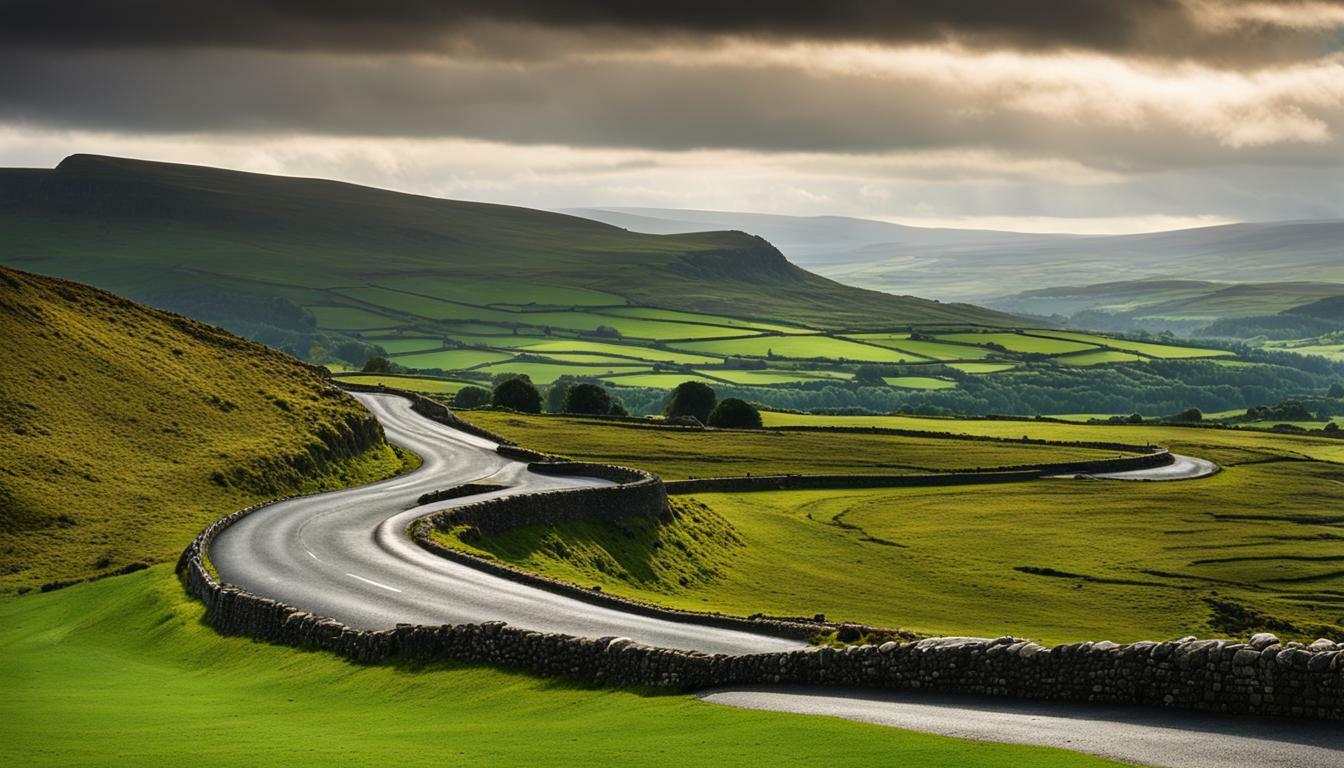Driving in Ireland
Embark on the thrill of driving in Ireland and explore its lush landscapes, picturesque towns, and historic sites firsthand.
Driving in Ireland as a tourist for the first time can be challenging, but with some preparation and knowledge of the rules, it can be a smooth experience. Here are some key points to keep in mind:
Key Takeaways:
- A valid driver's license is sufficient for tourists from the US, Canada, and EU. Other countries may require an International Driver's Permit.
- Third-party insurance is required, and credit card insurance is not accepted.
- Important documents to carry include your driver's license, passport (if it doesn't have a photo), vehicle registration document, rental contract, or letter of permission if the vehicle is not registered in your name.
- Drive on the left side of the road in Ireland and adhere to speed limits ranging from 50 kph (30 mph) in urban areas to 120 kph (74.5 mph) on motorways.
- The legal alcohol limit is 0.5 milligrams of alcohol per milliliter of blood. Never drink and drive.
- Tolls exist in the Republic of Ireland, including the M50 eFlow Barrier System. Payment can be made at toll booths or online.
- Ensure you have enough cash in euros or pounds for fuel, as some service stations may not accept credit cards.
- In case of an emergency, dial 112 or 999 for immediate assistance.
- Drive defensively, adhere to road signs and markings, and be cautious of cyclists and pedestrians.
- U-turns are generally prohibited, and overtaking should only be done on dual carriageways or motorways while following proper signaling and lane changing procedures.
By following these guidelines and being aware of the rules, driving in Ireland can be an enjoyable and safe experience. So, gear up and get ready to embark on an unforgettable road trip in the Emerald Isle.
Driving License and Insurance
Before hitting the Irish roads, make sure to have a valid driver's license and third-party insurance in place. For tourists from the US, Canada, and EU, a valid driver's license is sufficient. However, if you're from a different country, you may need to obtain an International Driver's Permit. It's always a good idea to check the specific requirements for your country before traveling.
When it comes to insurance, remember that third-party insurance is mandatory in Ireland. This means that you must have coverage that protects you against damage or injury caused to others. Be aware that credit card insurance is not accepted as a substitute for third-party insurance. To ensure a hassle-free experience, it's best to arrange insurance through a reputable car rental company or your own insurance provider.
While driving in Ireland, it's important to have the necessary documentation with you. Make sure to carry your driver's license, passport (if it doesn't have a photo), vehicle registration document, rental contract, or a letter of permission if the vehicle is not registered in your name. These documents may be required by authorities or rental companies at any time, so it's better to be prepared.
| Driving License | Insurance | Documents to Carry |
|---|---|---|
| Valid driver's license | Third-party coverage | Driver's license |
| Passport (if necessary) | ||
| Vehicle registration document | ||
| Rental contract or letter of permission | ||
By ensuring you have the required license and insurance, as well as the necessary documentation, you can have peace of mind while driving in Ireland as a tourist.
Essential Documents and Road Rules
When driving in Ireland, it's important to carry essential documents and familiarize yourself with the country's road rules. Here are some key points to keep in mind:
- Driving License: For tourists from the US, Canada, and EU, a valid driver's license is sufficient. Other countries may require an International Driver's Permit.
- Insurance: Third-party insurance is required, and credit card insurance is not accepted.
Make sure to carry your driver's license, passport (if it doesn't have a photo), vehicle registration document, rental contract, or letter of permission if the vehicle is not registered in your name.
| Road Rules | Details |
|---|---|
| Drive on the left side of the road | In Ireland, traffic moves on the left side of the road. Keep this in mind and stay on the left at all times. |
| Speed limits | The speed limits in Ireland range from 50 kph (30 mph) in urban areas to 120 kph (74.5 mph) on motorways. Observe the posted speed limits and adjust your driving accordingly. |
| Seat belts | Seat belts must be worn by all occupants in the vehicle. Ensure that everyone is properly buckled up before starting your journey. |
| Mobile phone usage | Using a mobile phone while driving is strictly forbidden in Ireland. Keep your phone away and avoid any distractions while behind the wheel. |
Familiarize yourself with these road rules to ensure a safe and smooth driving experience in Ireland.
Irish Road Signs
It's also essential to understand Irish road signs to navigate the country's roads effectively. Here are some commonly encountered road signs:
- Stop sign: A red octagonal sign with the word “Stop” written in white. Come to a complete halt at these signs.
- Speed limit sign: Circular sign with a number indicating the maximum speed limit for that road.
- No entry sign: A red circular sign with a white horizontal bar. Do not enter roads with this sign.
- Roundabout sign: A circular sign with arrows indicating the direction of traffic flow in the roundabout. Yield to traffic already in the roundabout.
Understanding these signs will help you navigate Irish roads safely and with confidence.
By carrying the necessary documents, familiarizing yourself with the road rules, and understanding the road signs, you'll be well-prepared for an enjoyable and hassle-free driving experience in Ireland.
Alcohol Limits and Toll Roads
It's crucial to be aware of the alcohol limits and the presence of toll roads when driving in Ireland as a tourist. To ensure your safety and comply with the law, it's essential to understand the regulations regarding alcohol consumption and how toll roads operate.
In Ireland, the legal alcohol limit for drivers is 0.5 milligrams of alcohol per milliliter of blood. This limit is strictly enforced, and driving under the influence of alcohol can lead to severe penalties, including fines, license suspension, and even imprisonment. It's vital to plan your activities accordingly and avoid drinking and driving to keep yourself and others safe on the road.
When it comes to toll roads in Ireland, it's important to note that they exist, especially in the Republic of Ireland. To use toll roads, you may need to pay a fee either at a toll booth or online, depending on the specific road. One notable example is the M50 around Dublin, which utilizes an eFlow Barrier System. Here, your license plate is photographed, and payment must be made online or at a designated kiosk.
| Toll Road | Payment Method |
|---|---|
| M50 | eFlow Barrier System – Online or Kiosk |
| Other Toll Roads | Toll Booth or Online |
To ensure a seamless journey, make sure you have the necessary means to pay the tolls, whether it's in cash or through online payment methods. Familiarize yourself with the toll road signage, and be prepared to follow the designated routes and payment procedures.
By understanding and adhering to the alcohol limits and toll road regulations, you can enjoy your driving experience in Ireland while staying safe and compliant. Remember to plan ahead, know the rules, and take necessary precautions. Have a wonderful time exploring the beautiful landscapes and vibrant cities of the Emerald Isle!
Fuel and Emergency Assistance
Ensure a smooth journey by being prepared with sufficient cash for fuel and knowing how to contact emergency services if needed. Here are some important points to keep in mind:
Fuel:
When driving in Ireland, it's important to note that service stations are available, but they can be small and might not accept credit cards. It is advisable to carry enough cash in euros or pounds to pay for fuel. Additionally, keep in mind that fuel prices in Ireland are measured in liters, so be aware of converting liters to gallons if you are used to the American system of measurement.
To help you plan your stops, here is a table showing the approximate fuel prices in Ireland as of [insert date]:
| Fuel Type | Price per Liter |
|---|---|
| Petrol (Unleaded) | €1.45 |
| Diesel | €1.35 |
Emergency Assistance:
In case of an emergency, it's crucial to know how to quickly contact the appropriate authorities. In Ireland, dial 112 or 999 for immediate assistance. These emergency numbers are toll-free and can be dialed from any phone, including mobile phones. It's important to stay calm and provide the operator with all the necessary information, such as your location and the nature of the emergency.
To help you remember these emergency numbers, here is a quote to keep in mind:
“In case of an emergency in Ireland, dial 112 or 999 for immediate assistance.”
By taking these precautions and being prepared, you can ensure a safe and hassle-free journey while driving in Ireland.
Driving Etiquette and Safety
To ensure a safe and pleasant driving experience in Ireland, it's essential to follow driving etiquette and prioritize road safety. Here are some tips to help you navigate the roads with ease:
- Familiarize yourself with road signs and markings: Understanding the various road signs and markings in Ireland is crucial. Take the time to study common signs, including speed limits, parking restrictions, and directional indicators. This will help you navigate unfamiliar roads confidently.
- Drive defensively: Irish roads can be narrow and winding, especially in rural areas. Always drive defensively, anticipating the actions of other drivers, cyclists, and pedestrians. Be prepared to slow down or yield to oncoming traffic when necessary.
- Be cautious of cyclists and pedestrians: Ireland is known for its beautiful landscapes, which often attract cyclists and pedestrians. Give them plenty of space and be patient when encountering them on the road. Exercise caution, especially in urban areas and near popular tourist destinations.
Additionally, it's important to adhere to the following road safety guidelines:
- Wear seat belts: Seat belts must be worn by all occupants of the vehicle, including those in the back seats. It's crucial to prioritize the safety of everyone in the car.
- Avoid using mobile phones: Using a mobile phone while driving is strictly forbidden in Ireland, unless you have a hands-free device. Keep your attention focused on the road at all times.
By following these driving tips and demonstrating respect for other road users, you can enjoy a smooth and stress-free journey through the stunning landscapes of Ireland.
| Important Road Rules | Key Points |
|---|---|
| Drive on the left side of the road | This is standard practice in Ireland. |
| Speed limits | Range from 50 kph (30 mph) in urban areas to 120 kph (74.5 mph) on motorways. |
| Legal alcohol limit | 0.5 milligrams of alcohol per milliliter of blood. |
| Toll roads | Exist in the Republic of Ireland. The M50 uses an eFlow Barrier System. |
| Emergency assistance | In case of an emergency, dial 112 or 999. |
U-Turns and Overtaking
Familiarize yourself with the rules around U-turns and overtaking to navigate Irish roads confidently. Here are some important guidelines:
- U-Turns: In Ireland, U-turns are generally prohibited unless it is safe to do so. Always check for road signs indicating U-turns are allowed. Be cautious of other vehicles and pedestrians before making a U-turn.
- Overtaking: When overtaking on Irish roads, it is essential to follow proper procedures. Overtake only on dual carriageways or motorways, where there are two or more lanes of traffic going in the same direction. Signal your intention to overtake, check mirrors, and ensure it is safe to proceed. Once you have completed the maneuver, signal again and return to your original lane.
Remember to be patient and cautious while overtaking. Maintain a safe distance from the vehicle you are overtaking and avoid excessive speed. Always prioritize road safety and adhere to the rules to ensure a smooth and enjoyable driving experience in Ireland.
| U-Turns | Overtaking |
|---|---|
| Generally prohibited unless safe | Only on dual carriageways or motorways |
| Check for road signs | Signal and check mirrors |
| Be cautious of other vehicles and pedestrians | Maintain a safe distance |
Conclusion
Driving in Ireland offers a thrilling adventure, and by adhering to the driving laws and tips, you can enjoy a safe and unforgettable experience.
As a tourist driving in Ireland for the first time, it's important to be prepared and familiarize yourself with the rules of the road. Make sure to carry a valid driver's license, and for some countries, an International Driver's Permit may be necessary. Third-party insurance is required, so be sure to arrange proper coverage.
When driving in Ireland, remember to carry important documents like your driver's license, passport, and rental contract or letter of permission if the vehicle is not registered in your name. It's also essential to understand the road rules, including driving on the left side and adhering to speed limits. Don't forget to wear seat belts, and never use a mobile phone while driving.
It's crucial to be aware of the legal alcohol limit while driving in Ireland, which is 0.5 milligrams of alcohol per milliliter of blood. Avoid drinking and driving to ensure your safety and the safety of others on the road.
When encountering toll roads in the Republic of Ireland, be prepared to make payments either at toll booths or online. For the M50 around Dublin, remember to use the eFlow Barrier System and make the necessary payment online or at a kiosk.
While fueling up, keep in mind that some service stations may not accept credit cards, so it's wise to carry enough cash in euros or pounds. In case of an emergency, dial 112 or 999 for immediate assistance.
Finally, driving etiquette is crucial in Ireland. Familiarize yourself with road signs and markings, drive defensively, and be cautious of cyclists and pedestrians. U-turns are generally prohibited unless conditions are safe, and overtaking should only be done on dual carriageways or motorways while following proper signaling and lane changing procedures.
By following these guidelines and being aware of the rules, driving in Ireland can be an enjoyable and safe experience. So buckle up, stay alert, and get ready to explore the stunning landscapes, vibrant cities, and charming towns that Ireland has to offer!
FAQ
What type of driving license do I need to drive in Ireland as a tourist?
For tourists from the US, Canada, and EU, a valid driver's license is sufficient. Other countries may require an International Driver's Permit.
Is credit card insurance accepted in Ireland?
No, credit card insurance is not accepted. Third-party insurance is required.
What documents do I need to carry while driving in Ireland?
You should carry your driver's license, passport (if it doesn't have a photo), vehicle registration document, rental contract, or a letter of permission if the vehicle is not registered in your name.
What are the road rules in Ireland?
In Ireland, you drive on the left side of the road. Speed limits range from 50 kph (30 mph) in urban areas to 120 kph (74.5 mph) on motorways. Seat belts must be worn by all occupants, and using a mobile phone while driving is strictly forbidden.
What is the legal alcohol limit for driving in Ireland?
The legal alcohol limit in Ireland is 0.5 milligrams of alcohol per milliliter of blood.
Are there toll roads in Ireland?
Yes, toll roads exist in the Republic of Ireland. Payment can be done at toll booths or online. The M50 around Dublin uses an eFlow Barrier System where the license plate is photographed, and payment must be made online or at a kiosk.
What type of payment is accepted at service stations in Ireland?
Service stations in Ireland may not accept credit cards, so it's advisable to have enough cash in euros or pounds.
What do I do in case of an emergency while driving in Ireland?
In case of an emergency, dial 112 or 999 for immediate assistance.
What should I be aware of in terms of driving etiquette and safety in Ireland?
Familiarize yourself with road signs and markings. Drive defensively, be cautious of cyclists and pedestrians, and follow proper signaling and lane changing procedures.
Can I make U-turns while driving in Ireland?
U-turns are generally prohibited unless conditions are safe.
When can I overtake on Irish roads?
Overtake only on dual carriageways or motorways and follow proper signaling and lane changing procedures.



